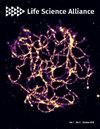Micronucleus is not a potent inducer of the cGAS/STING pathway.
IF 3.3
2区 生物学
Q1 BIOLOGY
引用次数: 0
Abstract
Micronuclei (MN) have been associated with the innate immune response. The abrupt rupture of MN membranes results in the accumulation of cGAS, potentially activating STING and downstream interferon-responsive genes. However, direct evidence connecting MN and cGAS activation has been lacking. We have developed the FuVis2 reporter system, which enables the visualization of the cell nucleus carrying a single sister chromatid fusion and, consequently, MN. Using this FuVis2 reporter equipped with cGAS and STING reporters, we rigorously assessed the potency of cGAS activation by MN in individual living cells. Our findings reveal that cGAS localization to membrane-ruptured MN during interphase is infrequent, with cGAS primarily capturing MN during mitosis and remaining bound to cytosolic chromatin. We found that cGAS accumulation during mitosis neither activates STING in the subsequent interphase nor triggers the interferon response. Gamma-ray irradiation activates STING independently of MN formation and cGAS localization to MN. These results suggest that cGAS accumulation in cytosolic MN is not a robust indicator of its activation and that MN are not the primary trigger of the cGAS/STING pathway.微核不是 cGAS/STING 通路的强效诱导剂。
微核(MN)与先天性免疫反应有关。MN 膜的突然破裂会导致 cGAS 的积累,从而可能激活 STING 和下游的干扰素反应基因。然而,目前还缺乏将 MN 和 cGAS 激活联系起来的直接证据。我们开发了 FuVis2 报告系统,该系统可使携带单姐妹染色单体融合的细胞核可视化,从而使 MN 可视化。利用这种配备了 cGAS 和 STING 报告器的 FuVis2 报告器,我们在单个活细胞中严格评估了 MN 激活 cGAS 的效力。我们的研究结果表明,cGAS 在间期很少定位到破膜的 MN 上,cGAS 主要是在有丝分裂期捕获 MN 并与细胞染色质结合。我们发现,cGAS在有丝分裂过程中的积累既不会在随后的间期激活STING,也不会触发干扰素反应。伽马射线照射激活 STING 与 MN 的形成和 cGAS 定位于 MN 无关。这些结果表明,cGAS在细胞膜MN中的积累并不是其激活的有力指标,MN也不是cGAS/STING通路的主要触发器。
本文章由计算机程序翻译,如有差异,请以英文原文为准。
求助全文
约1分钟内获得全文
求助全文
来源期刊

Life Science Alliance
Agricultural and Biological Sciences-Plant Science
CiteScore
5.80
自引率
2.30%
发文量
241
审稿时长
10 weeks
期刊介绍:
Life Science Alliance is a global, open-access, editorially independent, and peer-reviewed journal launched by an alliance of EMBO Press, Rockefeller University Press, and Cold Spring Harbor Laboratory Press. Life Science Alliance is committed to rapid, fair, and transparent publication of valuable research from across all areas in the life sciences.
 求助内容:
求助内容: 应助结果提醒方式:
应助结果提醒方式:


